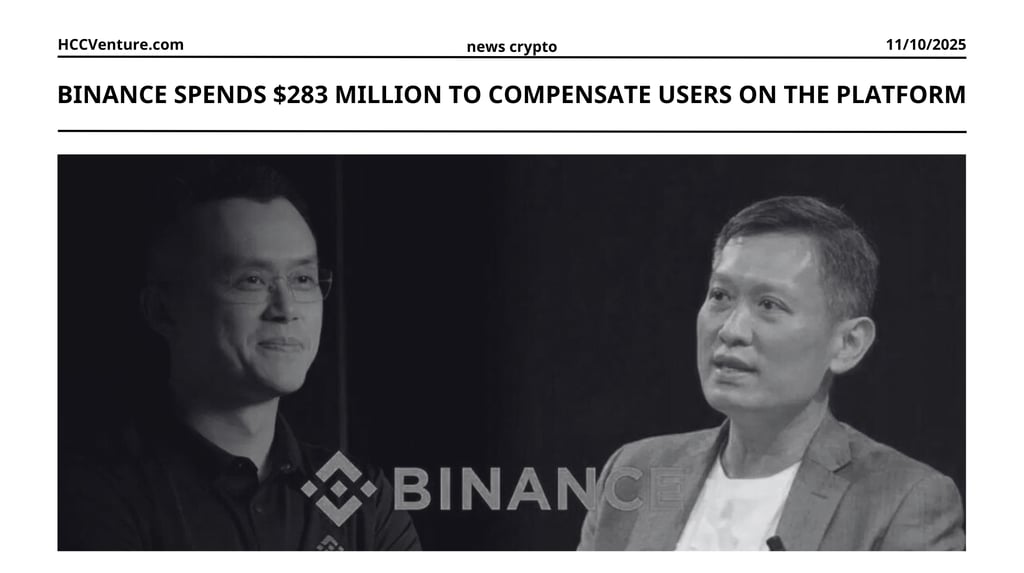Binance spends $283 million to compensate users on the platform
Binance has moved with unusual speed to heal the wounds from the chaotic dump, disbursing a whopping $283 million in compensation to users from forced liquidations involving USDe, BNSOL, and WBETH.
10/13/20252 min read


Black Friday of the market
According to internal reports and third-party analysis, the October 11 depeg event was triggered by a sudden imbalance in liquidity pools involving several stablecoins, including USDT, FDUSD, and a few smaller algorithmic tokens.
A combination of factors — including automated arbitrage loops, leveraged liquidations, and cross-chain bridge congestion — caused a temporary deviation from the $1 peg, with some stablecoins falling as low as $0.92 on Binance spot trading pairs. Although the depeg lasted less than two hours, its impact was amplified by:
High market leverage on futures pairs.
Automatic liquidations.
Price difference between Binance and external markets.
Binance's User Protection Fund and internal compensation committee conducted an immediate assessment after the incident to quantify affected positions and restore account balances.
USDe (Ethereum's synthetic dollar) fell the most, falling to $0.65 on Binance before recovering, while BNSOL (SOL packaged with BNB) and WBETH (ETH packaged with Beacon) traded at a fraction of their packaging levels, triggering a series of margin calls. Binance attributed the anomaly to an " old limit order " from 2019 being executed at a low price, amplified by a " display error " that caused the token to flash at $0, rather than an underlying protocol error.
Affected users—mostly leveraged traders—faced unrealized losses that exceeded the liquidation threshold, with Binance’s ADL (auto-deleveraging) mechanism kicking in to cover the short positions. The compensation formula? The difference between the liquidation price and the post-recovery market value, plus the lack of verified profits. USDE issuer Ethena also agreed with the fix, confirming there was no protocol violation but pledging to adjust the oracle. Total accounts affected? Thousands, although Binance has protected retail investors with risk buffers.
Details of compensation
This total includes both cash and token payments, calculated using a weighted average of stablecoin prices before and after the depeg. The compensation includes:
Spot traders are affected by unusual order execution.
Futures traders were liquidated due to distorted market prices.
Liquidity providers on Binance Earn and Launchpool products are linked to the affected assets. Divided into 2 phases:
Phase 1 (Immediate Fix): Binance partially compensated all affected user accounts within 48 hours of the incident, including direct losses incurred from forced liquidations and trades made during the depeg period.
Phase 2 (Post-Audit Adjustment): After a full audit of the transaction logs and liquidity provider data, a final additional payment was made to ensure full reimbursement, completed by the end of October.
A sobering warning from FTX to Binance
By voluntarily compensating users, Binance demonstrates its ability to manage risk at an institutional scale, unlike previous industry failures (e.g., FTX, Celsius) where user losses were not compensated.
This incident is said to have prompted Binance to upgrade its internal risk management tools. Enhanced real-time peg monitoring. Dynamic margin adjustments for stablecoin pairs. Cross-chain liquidity stress testing.
This $283 million payment sets a new standard for transparency in user reimbursements in the crypto space, signaling that major exchanges are adopting bank-like compensation frameworks for systemic market disruptions.
The event also highlights the fragility of liquidity networks across stablecoin markets — especially as new entrants (e.g., FDUSD, PYUSD, mUSD) add complexity. Binance’s response may encourage issuers and exchanges to tighten peg protections and improve market-making oversight.
Disclaimer: The information presented in this article is the author's personal opinion in the cryptocurrency field. It is not intended to be financial or investment advice. Any investment decision should be based on careful consideration of your personal portfolio and risk tolerance. The views expressed in this article do not represent the official position of the platform. We recommend that readers conduct their own research and consult with a professional before making any investment decisions.
Explore HCCVenture group
HCCVenture © 2023. All rights reserved.


Connect with us
Popular content
Contact to us
E-mail : holdcoincventure_contact@hccventure.com
Register : https://linktr.ee/holdcoincventure
Disclaimer: The information on this website is for informational purposes only and should not be considered investment advice. We are not responsible for any risks or losses arising from investment decisions based on the content here.


TERMS AND CONDITIONS • CUSTOMER PROTECTION POLICY
ANALYTICAL AND NEWS CONTENT IS COMPILED AND PROVIDED BY EXPERTS IN THE FIELD OF DIGITAL FINANCE AND BLOCKCHAIN BELONGING TO HCCVENTURE ORGANIZATION, INCLUDING OWNERSHIP OF THE CONTENT.
RESPONSIBLE FOR MANAGING ALL CONTENT AND ANALYSIS: HCCVENTURE FOUNDER - TRUONG MINH HUY
Read warnings about scams and phishing emails — REPORT A PROBLEM WITH OUR SITE.
